Monday, May 31st 2021

AMD Announces FidelityFX Super Resolution (FSR), its DLSS-rival
AMD finally made a big announcement on its ambitious FidelityFX Super Resolution (FSR) technology, the company's rival to NVIDIA's popular DLSS. Much like it, FSR aims to significantly improve gaming performance with minimal loss in image quality, through a sophisticated supersampling algorithm. At this point, AMD did not detail the nuts and bolts of the feature, but mentioned how the feature could look to gamers.
There are four FSR presets typically available to a supported game—Ultra Quality, Quality, Balanced, and Performance, which AMD claims offer performance gains of 59% for "Ultra Quality," 102% for "Quality," 153% for "Balanced," and 206% for "Performance." These should come particularly handy when playing games with raytracing on; and were measured on "Godfall" with RX 6800 XT, with 4K "epic" preset, and raytracing enabled. As of now, the company is working with over 10 game studios and game engine developers to integrate FSR, and the technology is expected to support "over 100 CPUs and GPUs."Update Jun 22nd: We have now posted our in-depth review of AMD Radeon FidelityFX Super Resolution (FSR).
The FSR slide-deck follows.
There are four FSR presets typically available to a supported game—Ultra Quality, Quality, Balanced, and Performance, which AMD claims offer performance gains of 59% for "Ultra Quality," 102% for "Quality," 153% for "Balanced," and 206% for "Performance." These should come particularly handy when playing games with raytracing on; and were measured on "Godfall" with RX 6800 XT, with 4K "epic" preset, and raytracing enabled. As of now, the company is working with over 10 game studios and game engine developers to integrate FSR, and the technology is expected to support "over 100 CPUs and GPUs."Update Jun 22nd: We have now posted our in-depth review of AMD Radeon FidelityFX Super Resolution (FSR).
The FSR slide-deck follows.

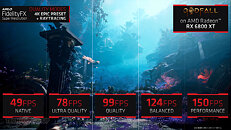
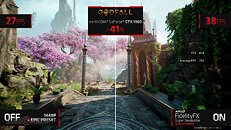
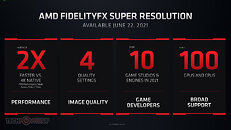
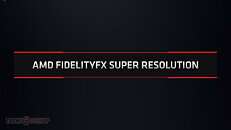
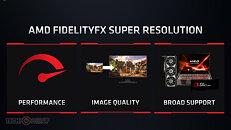
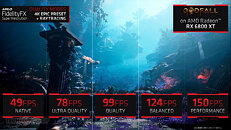
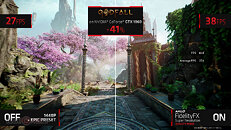


106 Comments on AMD Announces FidelityFX Super Resolution (FSR), its DLSS-rival
FSR will be open source, so Nvidia can look at the code and tweak their drivers accordingly. There isn't any specialized HW involved, it runs on shaders.
Did Nvidia tweaked its effects for AMD? Hairworks, PhysX, Gameworks...or AMD had to optimize their drivers themselves for proprietary closed source libraries.
I guess AMD could do it for them, if Nvidia open its software and hardware stack. :laugh:
I wonder if what you posted really made sense in your head.
Like "not at all".
As to the quoted image and the listed support, the 'select 3000 series' is because the 3000 series APU chips use an older tech - which complicates that.
Why is everyone picking on this game I don't get it. Also strange brigade same thing.Whenever AMD excels in a game, some people will always call the game demo.
Both are regular games like any other.
I'm currently waiting for the FSR so I can try it out with GodFall. To be frank, I can't wait to give it a try.
wccftech.com/no-amds-fsr-fidelityfx-super-resolution-is-not-a-dlss-alternative-and-here-is-why-you-should-care/?utm_source=feedburner&utm_medium=feed&utm_campaign=Feed%3A+Wccftechcom+%28WCCFtech.com%29
So, not really a DLSS competitor.
I wouldn't judge FSR just yet with what we've seen so far is like drop in the bucket.
Maybe it is worse on NV GTX and WCCFtech evaluate the FSR feature by the GTX 1060 image. The video looks much better though and it uses 6000 series graphics card.
Either way, I would refrain from judgment just yet.
FSR could be a success or a meh, or most likely something in between. We just don't know yet.
As funny (and stereotypical) is to see misunderstanding of tech from NV lovers.
It is getting embarrassing.
DirectML is an API for accessing GPUs.
It has nothing to do with any concrete ML activity (although it can be used for most of them)
So how can we run NV's DLSS on AMD's cards? Mmm, we can't. Last time I checked GTX doesn't support DLSS at all, only RTX does and it does incur latency penalty, + it took them years to get to a usable state that we see in latest Control and Metro. Original Metro DLSS was abominable and so it was in Control. And only selected few games even support DLSS.
So AMD's version runs on shaders, is free for everyone isn't it. Where as NV's version runs on tensor cores that works only on selected cards in selected situations otherwise the performance penalty is too high to use it.
And don't even get me on the blurry meme that is starting on here. DLSS, which I have and use in latest versions 2.0+, is blurry, there is no other way to say it, no amount of postprocessing sharpening will hide the lack of detail due to not rendering at native resolution. Is it better than plain old stupid bilinear or bicubic upscaling, with 2.0+ yes it finally is.
At least with Metro EE the improvements from what I've seen were not only to DLSS version but also a little to the game itself to run the ray tracing better, still the notoriously problematic areas remained.
There is no other way to make non blurry upscaling in real time. One would have to offline (non real time) upscale with expensive generative methods that add fake detail during upscale.
And I bet this AMD solution is likely to work on consoles too, or some variation of it from each company that orders consoles from AMD.
DLSS 2.X may have given up on AI inferencing silently altogether, too because it has resorted to using motion algorithms to place previous pixels in the current frame which works more generically for multiple resolutions and any games that generate the needed buffers. That sounds awfully like CBR, too o_O. So either the tensor cores are re-purposed to aid this new pipeline or they are now sitting idle. Imagine that, if AI upscaling is actually dead...
In the world of graphics rendering tricks, we have come full circle. Gaming was prime at 320x240 and eventually 640x480.
But nobody asks the most important question, how good games will looks with DLSS and FSR at the same time?
AMD has been doing so good lately, don't want to see them embarrass themselves, but I feel like that is with the path we are on. lol
Once we have cards again that is...